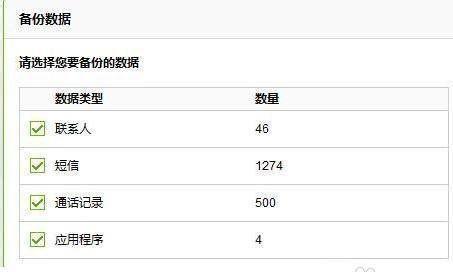 Mobile Tutorial
Mobile Tutorial
 Android Phone
Android Phone
 Recommended software for backing up application data (protect your application data)
Recommended software for backing up application data (protect your application data)
Recommended software for backing up application data (protect your application data)
With the advancement of technology, smartphones and computers have become indispensable tools in our lives. We use them to store photos, videos, manage daily tasks and other important data. However, accidents can always happen, such as operator error, equipment damage or theft. To avoid data loss, regular backup of application data is crucial. To this end, PHP editor Youzi has compiled several excellent backup application data software to help you better protect your valuable data. The following content will provide an in-depth introduction to these software and their features, guiding you to choose the solution that best suits your needs.

1: iCloud Backup (iCloudBackup)
It can automatically back up your iPhone, including apps, text messages, etc., photos, contacts, iCloudBackup is A cloud backup service provided by Apple for all data on your iPad or iPod touch. The device will automatically back up when connected to Wi-Fi, you just need to turn on iCloud Backup-Fi in settings and plug in the charger. This feature is very convenient since you don't need to manually operate or connect to a computer.
2: Google Drive (GoogleDrive)
In addition to storing and sharing files, Google Drive is a cloud storage service provided by Google. It can also back up your mobile application data. Automatically back up application data to the cloud by downloading the GoogleDrive application and logging in to your Google account. Even if your phone is lost or damaged, you can still easily recover app data this way.

3: OneDrive
It can also be used as a tool to back up application data. OneDrive is a cloud storage service provided by Microsoft. To back up app data to the cloud, you can set automatic backup options by downloading the OneDrive app and logging in to your Microsoft account. It is convenient for you to backup data on different devices, and OneDrive can also be synchronized with other devices.
Four: Helium Backup (HeliumBackup)
HeliumBackup is a tool for backing up application data on Android devices. Photos, and supports saving backup files to SD card or cloud storage service. It can back up all data including application data, contacts, etc. Very convenient and easy to use, HeliumBackup also provides backup functions without Root permissions.
5: Titanium Backup (TitaniumBackup)
It requires the device to be Rooted before it can be used normally. TitaniumBackup is another tool for backing up Android application data. Even system applications, you can back up and restore applications and their data through TitaniumBackup. To meet the needs of different users, the tool provides many advanced features such as batch backup and scheduled backup.

6: SuperBackup&Restore
SuperBackup&Restore is a simple and easy-to-use tool for backing up Android device application data. Contacts, call history, etc. It supports backup of application data and can save backup files to SD card or cloud storage service, SMS. To ensure your data is always protected, SuperBackup&Restore can also set up regular backups.
Seven: Dropbox
It can also be used as a tool to back up application data. Dropbox is a well-known cloud storage service provider. To back up application data to the cloud, you can download the Dropbox application and log in to your account. It is convenient for you to share backed up data with others. Dropbox also supports sharing files and folders.
Eight: Local Backup Tools
You can also choose to use local backup tools to protect application data, in addition to cloud backup. Allows you to back up app data to an SD card or computer. Many Android devices come with built-in backup capabilities. And perform manual or automatic backups as needed, you can find these options in the settings.
9: Use third-party backup applications
There are many third-party backup applications to choose from, in addition to the software mentioned above. These apps typically offer more functionality and flexible setup options. BackupYourMobile, etc., AppBackup&Restore, for example. You can choose the software that best suits your backup application data based on your needs.
Ten: Choose the appropriate backup method
You need to consider some factors when choosing software to back up application data, such as data volume, privacy protection and ease of use. However, a certain network connection may be required, and cloud backup usually provides larger storage space and convenient recovery methods. However, you need to manage your own storage devices and perform regular backup operations. Local backup is safer. You can choose the backup method that best suits you based on your needs and circumstances.
11: Check backups regularly
It is very important to check backups regularly, no matter which backup method you choose. But still need to ensure that the backup is successful, you can set the automatic backup option. To protect your data from loss, regular checks can help you detect failed or incomplete backups and take timely action.
Twelve: Multiple backup strategies
Multiple backup strategies are a good choice to better protect your application data. Make sure your data is backed up on different storage devices. You can use both cloud backup and local backup tools. You can still recover data from other backups, even if something goes wrong with one backup, this way.
13: Things to note when restoring application data
You need to pay attention to some things when you need to restore application data. Make sure the backup file you choose is correct and complete. To ensure that the recovery process goes smoothly, follow the recovery guide provided by the software. To avoid data loss or errors, remember to check data integrity after recovery.
Fourteen: The importance of backing up application data
The importance of backing up application data cannot be ignored. Avoid the hassle of data loss or damage, it can help you protect important personal and work data. And check and update backups regularly, choose a backup method that suits you, whether using cloud backup or local backup tools, to ensure that your data is always protected.
Fifteen:
Backing up application data is an important measure to protect personal and work data in the digital age. HeliumBackup, SuperBackup&Restore, OneDrive, including iCloudBackup, we recommend several software for backing up application data, TitaniumBackup, GoogleDrive, Dropbox, etc. You can protect your data from loss by choosing appropriate backup methods and checking backups regularly. Backing up your app data is a critical step in protecting your important data, no matter which backup method you choose.
The above is the detailed content of Recommended software for backing up application data (protect your application data). For more information, please follow other related articles on the PHP Chinese website!

Hot AI Tools

Undresser.AI Undress
AI-powered app for creating realistic nude photos

AI Clothes Remover
Online AI tool for removing clothes from photos.

Undress AI Tool
Undress images for free

Clothoff.io
AI clothes remover

AI Hentai Generator
Generate AI Hentai for free.

Hot Article

Hot Tools

Notepad++7.3.1
Easy-to-use and free code editor

SublimeText3 Chinese version
Chinese version, very easy to use

Zend Studio 13.0.1
Powerful PHP integrated development environment

Dreamweaver CS6
Visual web development tools

SublimeText3 Mac version
God-level code editing software (SublimeText3)

Hot Topics
 1378
1378
 52
52
 How to use sql datetime
Apr 09, 2025 pm 06:09 PM
How to use sql datetime
Apr 09, 2025 pm 06:09 PM
The DATETIME data type is used to store high-precision date and time information, ranging from 0001-01-01 00:00:00 to 9999-12-31 23:59:59.99999999, and the syntax is DATETIME(precision), where precision specifies the accuracy after the decimal point (0-7), and the default is 3. It supports sorting, calculation, and time zone conversion functions, but needs to be aware of potential issues when converting precision, range and time zones.
 Can I retrieve the database password in Navicat?
Apr 08, 2025 pm 09:51 PM
Can I retrieve the database password in Navicat?
Apr 08, 2025 pm 09:51 PM
Navicat itself does not store the database password, and can only retrieve the encrypted password. Solution: 1. Check the password manager; 2. Check Navicat's "Remember Password" function; 3. Reset the database password; 4. Contact the database administrator.
 How to delete rows that meet certain criteria in SQL
Apr 09, 2025 pm 12:24 PM
How to delete rows that meet certain criteria in SQL
Apr 09, 2025 pm 12:24 PM
Use the DELETE statement to delete data from the database and specify the deletion criteria through the WHERE clause. Example syntax: DELETE FROM table_name WHERE condition; Note: Back up data before performing a DELETE operation, verify statements in the test environment, use the LIMIT clause to limit the number of deleted rows, carefully check the WHERE clause to avoid misdeletion, and use indexes to optimize the deletion efficiency of large tables.
 How to recover data after SQL deletes rows
Apr 09, 2025 pm 12:21 PM
How to recover data after SQL deletes rows
Apr 09, 2025 pm 12:21 PM
Recovering deleted rows directly from the database is usually impossible unless there is a backup or transaction rollback mechanism. Key point: Transaction rollback: Execute ROLLBACK before the transaction is committed to recover data. Backup: Regular backup of the database can be used to quickly restore data. Database snapshot: You can create a read-only copy of the database and restore the data after the data is deleted accidentally. Use DELETE statement with caution: Check the conditions carefully to avoid accidentally deleting data. Use the WHERE clause: explicitly specify the data to be deleted. Use the test environment: Test before performing a DELETE operation.
 How to add columns in PostgreSQL?
Apr 09, 2025 pm 12:36 PM
How to add columns in PostgreSQL?
Apr 09, 2025 pm 12:36 PM
PostgreSQL The method to add columns is to use the ALTER TABLE command and consider the following details: Data type: Select the type that is suitable for the new column to store data, such as INT or VARCHAR. Default: Specify the default value of the new column through the DEFAULT keyword, avoiding the value of NULL. Constraints: Add NOT NULL, UNIQUE, or CHECK constraints as needed. Concurrent operations: Use transactions or other concurrency control mechanisms to handle lock conflicts when adding columns.
 Navicat's method to view PostgreSQL database password
Apr 08, 2025 pm 09:57 PM
Navicat's method to view PostgreSQL database password
Apr 08, 2025 pm 09:57 PM
It is impossible to view PostgreSQL passwords directly from Navicat, because Navicat stores passwords encrypted for security reasons. To confirm the password, try to connect to the database; to modify the password, please use the graphical interface of psql or Navicat; for other purposes, you need to configure connection parameters in the code to avoid hard-coded passwords. To enhance security, it is recommended to use strong passwords, periodic modifications and enable multi-factor authentication.
 How to clean all data with redis
Apr 10, 2025 pm 05:06 PM
How to clean all data with redis
Apr 10, 2025 pm 05:06 PM
How to clean all Redis data: Redis 2.8 and later: The FLUSHALL command deletes all key-value pairs. Redis 2.6 and earlier: Use the DEL command to delete keys one by one or use the Redis client to delete methods. Alternative: Restart the Redis service (use with caution), or use the Redis client (such as flushall() or flushdb()).
 How to solve data loss with redis
Apr 10, 2025 pm 08:24 PM
How to solve data loss with redis
Apr 10, 2025 pm 08:24 PM
Redis data loss causes include memory failures, power outages, human errors, and hardware failures. The solutions are: 1. Store data to disk with RDB or AOF persistence; 2. Copy to multiple servers for high availability; 3. HA with Redis Sentinel or Redis Cluster; 4. Create snapshots to back up data; 5. Implement best practices such as persistence, replication, snapshots, monitoring, and security measures.



